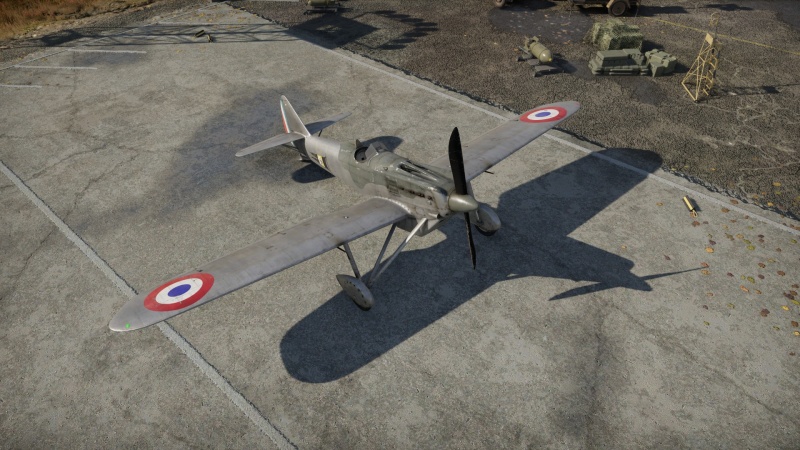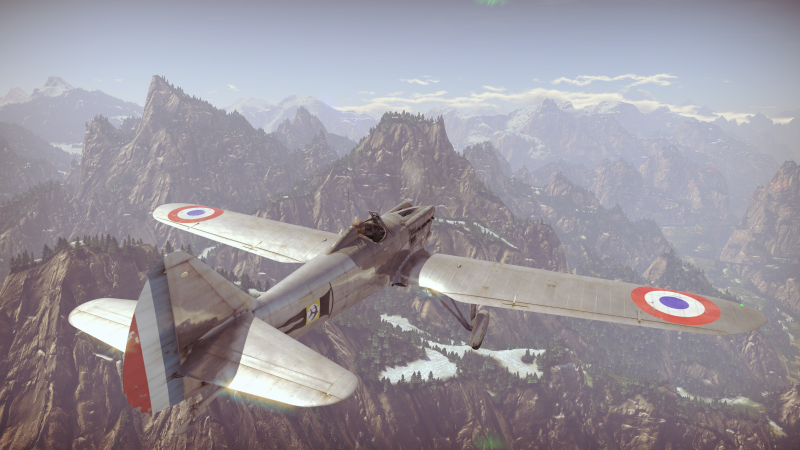D.500
Contents
Description
The D.500 was the replacement for the NiD-62 fighters which was still in operational service with France in the early 1930s. Because of this the French Air Ministry issued a new order for a fighter capable of replacing the aging NiD-62, an all metal interceptor was developed, this was the D.500. The aircraft was adopted in 1935, and it was a very competent fighter for its time, but it was quickly surpassed by more competent designs such as the M.S.406. The aircraft never saw combat in the Battle of France, and its direct successor was the D.520.
It was introduced in Update 1.73 "Vive la France". The D.500 is an all-metal mono-wing French aircraft with an open cockpit and fixed landing gear being built all through the mid-1930s. This fighter was France's primary fighter aircraft until the Morane-Saulnier M.S.406 fighter replaced it in 1939. When playing Simulator Battles (or Arcade and Realistic Battles in cockpit view), this aircraft offers excellent visibility only really limiting visibility where the wings protrude out of the fuselage. This aircraft boasts 1,200 rounds of ammunition split between four machine guns which can do severe damage especially when gun convergence is between 150 and 350 m.
General info
Flight performance
As an early monoplane fighter, the D.500 handles quite well for a plane of its era. The aircraft's acceleration and climb rate are all quite satisfactory for a reserve fighter, though it should be noted that the sea-level top speed is quite low, at just over 300 km/h in level flight. The plane has a decent turn rate, but will not be able to out-turn manuveurable biplane fighters such as the I-15. It should also be noted that the aircraft's engine doesn't have a WEP setting in Realistic Battles, and can overheat if left on 100% throttle for too long. The plane's control surfaces are all quite responsive and perform quite well at speeds between 250-350 km/h.
| Characteristics | Max Speed (km/h at 5,000 m) |
Max altitude (metres) |
Turn time (seconds) |
Rate of climb (metres/second) |
Take-off run (metres) | |||
|---|---|---|---|---|---|---|---|---|
| AB | RB | AB | RB | AB | RB | |||
| Stock | 355 | 349 | 15.7 | 16.3 | 10.4 | 10.4 | 150 | |
| Upgraded | 378 | 366 | 14.4 | 15.0 | 14.7 | 12.5 | ||
Details
| Features | ||||
|---|---|---|---|---|
| Combat flaps | Take-off flaps | Landing flaps | Air brakes | Arrestor gear |
| X | X | X | X | X |
| Limits | ||||||
|---|---|---|---|---|---|---|
| Wings (km/h) | Gear (km/h) | Flaps (km/h) | Max Static G | |||
| Combat | Take-off | Landing | + | - | ||
| 576 | - | - | - | ~13 | ~8 | |
| Optimal velocities (km/h) | |||
|---|---|---|---|
| Ailerons | Rudder | Elevators | Radiator |
| < 320 | < 330 | < 360 | > 280 |
Survivability and armour
- 3 mm Steel plate behind engine.
- 3 mm Steel plate on pilot's seat.
Modifications and economy
Armaments
Offensive armament
The D.500 is armed with:
- 2 x 7.5 mm Darne 1933 machine guns, nose-mounted (300 rpg = 600 total)
- 2 x 7.5 mm MAC 1934 machine guns, wing-mounted (300 rpg = 600 total)
The four machine guns are arranged with the two Darne 1933 guns mounted in the nose and the two MAC 1934 guns mounted on the underside of each wing. Each are armed with the same amount of ammunition, which means that all guns will fire together until empty.
Usage in battles
The D.500 is a good beginner aircraft for newer pilots. This airplane in the French tech tree is only one of two non-biplane aircraft offered as a reserve aircraft; the P-26 Peashooter being the other. This aircraft is an excellent aircraft for in-close fighting. Bringing in the gun convergence between 150 and 350 m and then targeting an enemy fighter/bomber aircraft within that range or closer will allow for all four guns to do the most damage along with potentially setting alight the enemy vehicle. This aircraft can switch between attacking aircraft and ground vehicles with no problems as it is still quite manoeuvrable at lower speeds and altitudes. Long continued bursts from the guns can quickly lead to the machine guns jamming: instead, utilise short controlled bursts which should allow you to avoid that. In Arcade Battle, the relatively short ammunition reload rate (~10 seconds) will have you back in action fairly quickly. This aircraft is a very good plane in simulator battles because of its superior visibility as it has no canopy.
Manual Engine Control
| MEC elements | ||||||
|---|---|---|---|---|---|---|
| Mixer | Pitch | Radiator | Supercharger | Turbocharger | ||
| Oil | Water | Type | ||||
| Not controllable | Not controllable Not auto controlled |
Not controllable Not auto controlled |
Controllable Not auto controlled |
Combined | Not controllable 1 gear |
Not controllable |
Pros and cons
Pros:
- Very manoeuvrable
- Pretty agile, can sometimes turnfight biplanes
- Speed is adequate
- Great over-the-nose visibility allowing easy aiming in a simulator dogfight
- Easy to control at low speeds meaning forgiving landing characteristics for realistic / simulator
- Open cockpit allows player to hear outside sounds easily, which is beneficial in noticing nearby enemies in simulator
- Guns are powerful at the rank
- Short gun convergence (150-350 m) chews up aircraft at short ranges
- Fixed landing gear makes landings easier
Cons:
- Low speed limit
- While not the fastest, usually not an issue
- No flap controls limiting its turning potential
- Fixed landing gear creates more drag
- Weak armour. No rear protection at all for the pilot. Open cockpit is also vulnerable to pilot sniping
History
In 1930, the French Air Ministry issued a new specification, C1, for a new fighter to replace the obsolete NiD-62 fighters then in service with the French Air force. Several companies rushed to develop an aircraft for the specification, including the French manufacturer Dewoitine. They designed an all-metal interceptor with fixed landing gear, and submitted their proposal, named D.500, to the Air Ministry. The aircraft performed its first flight on June 18th of 1932, and in November of 1933, the Air Ministry ordered an initial batch of 60 fighters.
The first models of the D. 500 were inducted into the French Air Force at the beginning of 1935. At the time, the aircraft was one of the most advanced fighters available, featuring a variety of innovative features. The aircraft operated as the primary French fighter from 1935 to 1939, even though the design was rapidly becoming obsolete due the advent of new technologies. In 1939, the aircraft were replaced in front-line duty by the more capable M.S.406, and remaining D.500s were relegated to training and regional defence squadrons.
At the start of the Second World War, the bulk of France's air force consisted of aircraft from the D. 500 family, including about 80 D. 500s. Due to its obsolescence, the aircraft did not see active service during the Battle of France, and the majority were broken up by the Germans after the French Armistice. The aircraft's technological advances were inherited by its direct successor, the D.520. In total, 102 D.500s airframes were manufactured, including a prototype and three aircraft sold to Venezuela. A total of 381 D.500 family aircraft were built, most of which had been retired by the early days of the Second World War.
Media
- Skins
See also
Links to the articles on the War Thunder Wiki that you think will be useful for the reader, for example:
- reference to the series of the aircraft;
- links to approximate analogues of other nations and research trees.
External links
| Dewoitine (SNCAM/SNCASE) | |
|---|---|
| Fighters | |
| D.37 | D.371 · D.371 H.S.9 · D.373 |
| D.500 | D.500 · D.501 · Pallier's D.510 |
| D.520 | D.520 · ▄D.520 · ▄D.521 |
| Export | ␗D.510C |
| France fighters | |
|---|---|
| Dewoitine | D.371 · D.371 H.S.9 · D.373 · D.500 · D.501 · Pallier's D.510 · D.520 |
| Morane-Saulnier | M.S.405C1 · M.S.406C1 · M.S.410 |
| Arsenal | V.G.33C-1 |
| Bloch | M.B.152C1 · M.B.157 |
| Caudron | C.R.714 |
| Sud-Ouest | S.O.8000 Narval |
| American | H-75A-1 · H-75A-4 · ▄P-39Q-25 · ▄P-40F-5 Lafayette · ▄P-47D-22-RE · ▄P-63C-5 · F-6C-10-NA |
| ▄F6F-5 · ▄F6F-5N · F4U-7 · ▄F8F-1B | |
| Other countries | ▄Seafire LF Mk.III · ▄Yak-3 · Challe's ▄Yak-9T · NC.900 |
| Belgium | ▄Gladiator Mk I · ▄Spitfire FR Mk XIVe |
| Netherlands | ◘Sea Fury FB 51 |






